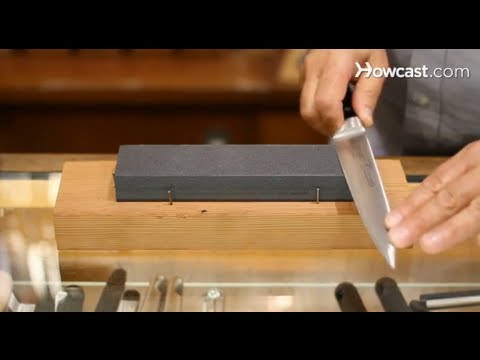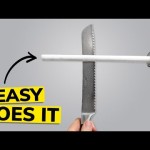
801429c6a98c1003206e469c566a61f3
Sharpening a knife is an important skill to have in the kitchen. It is essential for keeping your knives in top condition and ensuring that they are safe to use. In this guide, we will discuss the basics of sharpening a knife with an oilstone. We will cover the different types of oilstones, the proper technique for sharpening, and the best way to maintain your oilstone. With this information, you will be able to keep your knives sharp and safe for years to come.
How do you sharpen a knife with a stone and guide
Sharpening a knife with a stone and guide is a great way to keep your knives in top condition. It is a simple process that requires a few basic tools and a bit of practice. With the right technique, you can easily sharpen your knives and keep them sharp for years to come.
What You Need
Before you begin sharpening your knives, you will need to gather the necessary tools. You will need a sharpening stone, a guide, and a honing oil. The sharpening stone should be a medium-grit stone, such as a 1000/6000 combination stone. The guide should be a flat, metal guide that fits the blade of your knife. The honing oil will help to lubricate the stone and protect the blade from damage.
Sharpening the Knife
Once you have gathered the necessary tools, you can begin sharpening your knife. Start by placing the guide on the blade of the knife. This will help to keep the blade at a consistent angle while you sharpen. Next, apply a few drops of honing oil to the stone. This will help to lubricate the stone and protect the blade from damage.
Now, hold the knife at a 20-degree angle and begin to move the blade across the stone in a circular motion. Make sure to keep the blade at the same angle throughout the process. Continue to move the blade across the stone until you have achieved the desired sharpness.
Testing the Edge
Once you have finished sharpening the knife, it is important to test the edge. To do this, you can use a piece of paper or a tomato. If the knife easily slices through the paper or tomato, then the edge is sharp. If not, then you will need to repeat the sharpening process.
Caring for Your Knife
Once you have sharpened your knife, it is important to take care of it. Make sure to clean and dry the blade after each use. You should also store the knife in a safe place, such as a knife block or a sheath. This will help to protect the blade from damage and keep it sharp for years to come.
Conclusion
Sharpening a knife with a stone and guide is a simple process that requires a few basic tools and a bit of practice. With the right technique, you can easily sharpen your knives and keep them sharp for years to come. Make sure to test the edge after sharpening and take care of your knife to ensure it stays sharp.
What is the best angle guide for sharpening knives
Sharpening knives is an important part of kitchen maintenance. A sharp knife is safer and more efficient to use than a dull one. To ensure that your knives are sharpened correctly, it is important to use the right angle guide. Angle guides are tools that help you maintain the correct angle when sharpening a knife.
The most important factor when choosing an angle guide is the type of knife you are sharpening. Different knives require different angles for optimal sharpening. For example, a chef’s knife should be sharpened at a 20-degree angle, while a pocket knife should be sharpened at a 15-degree angle.
The second factor to consider is the material of the angle guide. Most angle guides are made of plastic or metal. Plastic angle guides are lightweight and easy to use, but they are not as durable as metal angle guides. Metal angle guides are more expensive, but they are more durable and can be used for a longer period of time.
The third factor to consider is the size of the angle guide. Smaller angle guides are easier to use and can be used on a variety of knives. Larger angle guides are more suitable for larger knives, such as chef’s knives.
Finally, consider the price of the angle guide. Angle guides range in price from a few dollars to several hundred dollars.
The more expensive angle guides are usually made of higher quality materials and are more durable.
When choosing an angle guide for sharpening knives, it is important to consider the type of knife, the material of the angle guide, the size of the angle guide, and the price. With the right angle guide, you can ensure that your knives are sharpened correctly and safely.
What liquid do you use while sharpening a tool on an oilstone
Sharpening a tool on an oilstone is a great way to keep your tools in top condition. An oilstone is a type of sharpening stone that is made from a combination of aluminum oxide and silicon carbide. It is used to sharpen tools such as knives, chisels, and other cutting tools. To get the best results, it is important to use the right liquid when sharpening a tool on an oilstone.
Mineral oil is the most common liquid used when sharpening a tool on an oilstone. Mineral oil is a clear, odorless oil that is derived from petroleum. It is non-toxic and does not evaporate, making it an ideal choice for sharpening tools. Mineral oil helps to lubricate the stone and reduce friction, which helps to keep the tool sharp.
Water can also be used when sharpening a tool on an oilstone. Water helps to keep the stone clean and free of debris. It also helps to reduce friction and keep the tool sharp. However, water can cause the stone to wear down faster, so it is important to use it sparingly.
Synthetic oil is another option for sharpening a tool on an oilstone. Synthetic oil is a petroleum-based oil that is designed to provide superior lubrication and protection. It is also more resistant to evaporation than mineral oil, making it a good choice for sharpening tools.
No matter which liquid you choose to use when sharpening a tool on an oilstone, it is important to use it sparingly. Too much liquid can cause the stone to become clogged and reduce its effectiveness. It is also important to clean the stone after each use to ensure that it remains in good condition.
How do you sharpen a knife with a guide
Sharpening a knife is an important part of knife maintenance. It is important to keep your knives sharp to ensure they are safe and effective to use. A guide is a great tool to help you sharpen your knives quickly and easily. Here is a step-by-step guide on how to sharpen a knife with a guide.
Step 1: Gather the Necessary Tools
Before you begin sharpening your knife, you will need to gather the necessary tools. You will need a sharpening guide, a sharpening stone, and a honing steel. You may also want to have a cloth or towel handy to wipe off the blade after sharpening.
Step 2: Secure the Knife in the Guide
Once you have all the necessary tools, you will need to secure the knife in the guide. Place the blade of the knife in the guide and make sure it is secure. Make sure the blade is aligned with the guide and that it is not loose.
Step 3: Sharpen the Knife
Now that the knife is secure in the guide, you can begin sharpening the knife. Start by running the blade along the sharpening stone. Make sure to keep the blade at the same angle as the guide. Move the blade back and forth along the stone until it is sharp.
Step 4: Hone the Knife
Once the blade is sharp, you will need to hone it. To do this, run the blade along the honing steel. Make sure to keep the blade at the same angle as the guide. Move the blade back and forth along the steel until it is honed.
Step 5: Clean the Knife
Once the blade is sharp and honed, you will need to clean it. Use a cloth or towel to wipe off the blade. Make sure to remove any debris or residue that may have accumulated during the sharpening process.
Conclusion
Sharpening a knife with a guide is a quick and easy way to keep your knives sharp and safe. By following the steps outlined above, you can easily sharpen your knives with a guide. Make sure to always use caution when sharpening knives and to keep your knives clean and sharp.
We hope this guide has been helpful in teaching you how to sharpen your knife with an oilstone. With a little practice, you’ll be able to keep your knives sharp and in top condition. Goodbye and happy sharpening!















